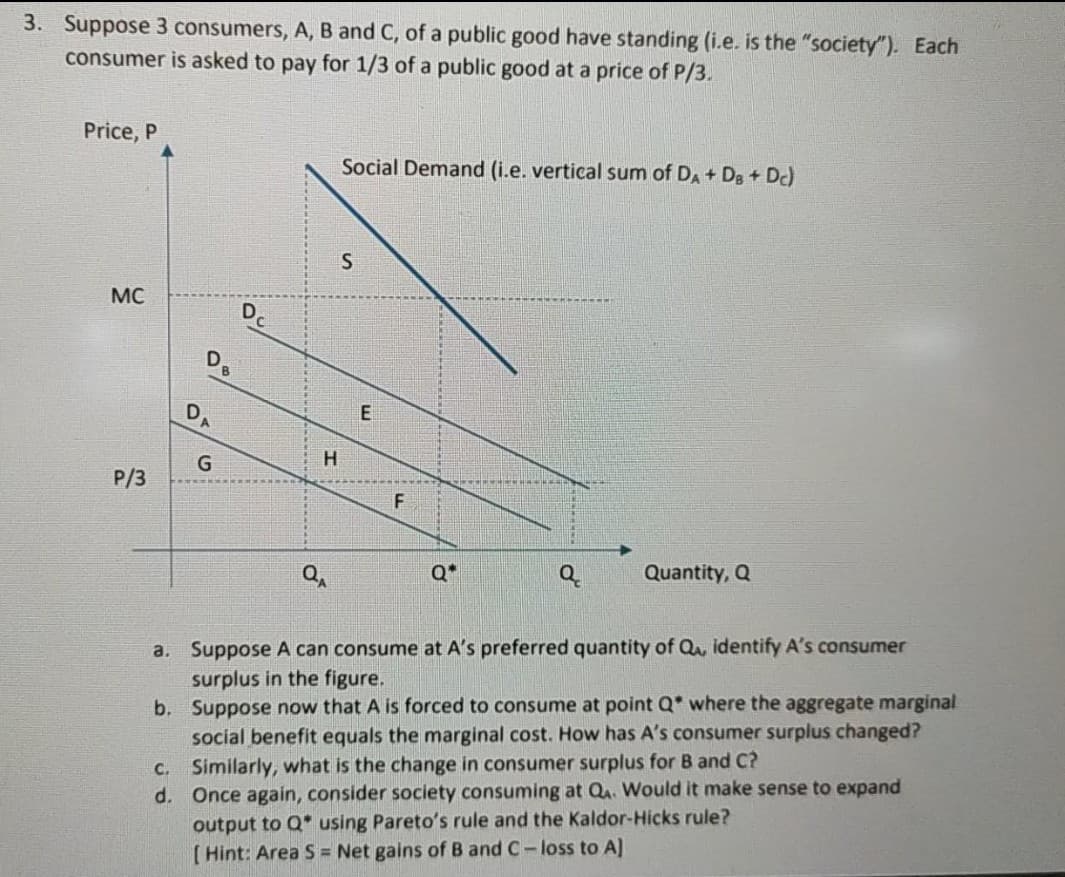Suppose 3 consumers, A, B and C, of a public good have standing (i.e. is the "society"). Ea consumer is asked to pay for 1/3 of a public good at a price of P/3. Price, P Social Demand (i.e. vertical sum of DA+ DB + Dc) S MC
Suppose 3 consumers, A, B and C, of a public good have standing (i.e. is the "society"). Ea consumer is asked to pay for 1/3 of a public good at a price of P/3. Price, P Social Demand (i.e. vertical sum of DA+ DB + Dc) S MC
Principles of Microeconomics
7th Edition
ISBN:9781305156050
Author:N. Gregory Mankiw
Publisher:N. Gregory Mankiw
Chapter11: Public Goods And Common Resources
Section: Chapter Questions
Problem 2PA
Related questions
Question
100%
Q. 1
hi, could you help me for the whole of qn 3? thanks a lot!!

Transcribed Image Text:3. Suppose 3 consumers, A, B and C, of a public good have standing (i.e. is the "society"). Each
consumer is asked to pay for 1/3 of a public good at a price of P/3.
Price, P
Social Demand (i.e. vertical sum of DA + DB + Dc)
S
MC
D.
D,
H.
P/3
Q*
Quantity, Q
a. Suppose A can consume at A's preferred quantity of Q, identify A's consumer
surplus in the figure.
b. Suppose now that A is forced to consume at point Q* where the aggregate marginal
social benefit equals the marginal cost. How has A's consumer surplus changed?
C. Similarly, what is the change in consumer surplus for B and C?
d. Once again, consider society consuming at Q. Would it make sense to expand
output to Q* using Pareto's rule and the Kaldor-Hicks rule?
(Hint: Area S = Net gains of B and C-loss to A)
Expert Solution
This question has been solved!
Explore an expertly crafted, step-by-step solution for a thorough understanding of key concepts.
Step by step
Solved in 2 steps with 1 images

Knowledge Booster
Learn more about
Need a deep-dive on the concept behind this application? Look no further. Learn more about this topic, economics and related others by exploring similar questions and additional content below.Recommended textbooks for you

Principles of Microeconomics
Economics
ISBN:
9781305156050
Author:
N. Gregory Mankiw
Publisher:
Cengage Learning

Essentials of Economics (MindTap Course List)
Economics
ISBN:
9781337091992
Author:
N. Gregory Mankiw
Publisher:
Cengage Learning

Principles of Microeconomics
Economics
ISBN:
9781305156050
Author:
N. Gregory Mankiw
Publisher:
Cengage Learning

Essentials of Economics (MindTap Course List)
Economics
ISBN:
9781337091992
Author:
N. Gregory Mankiw
Publisher:
Cengage Learning